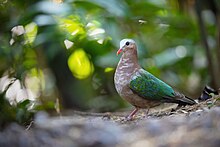
The stock dove or stock pigeon is a species of bird in the family Columbidae, the doves and pigeons. It is widely distributed in the western Palearctic.

The European turtle dove is a threatened or vulnerable member of the bird family Columbidae, the doves and pigeons. It breeds over a wide area of the south western Palearctic including north Africa but migrates to northern sub-Saharan Africa to winter.

The common wood pigeon, also known as simply wood pigeon, is a large species in the dove and pigeon family (Columbidae), native to the western Palearctic. It belongs to the genus Columba, which includes closely related species such as the rock dove. It has a flexible diet, predominantly feeding on vegetable matter, including cereal crops, leading to them being regarded as an agricultural pest. Wood pigeons are extensively hunted over large parts of their range, but this does not seem to have a great impact on their population.
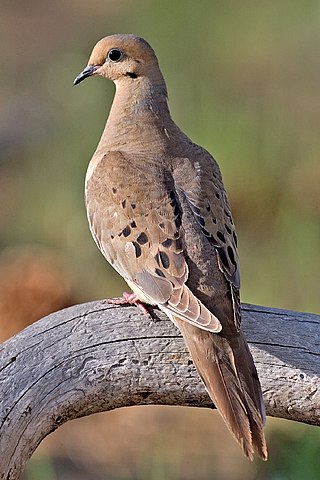
The mourning dove is a member of the dove family, Columbidae. The bird is also known as the American mourning dove, the rain dove, the chueybird, colloquially as the turtle dove, and it was once known as the Carolina pigeon and Carolina turtledove. It is one of the most abundant and widespread North American birds and a popular gamebird, with more than 20 million birds shot annually in the U.S., both for sport and meat. Its ability to sustain its population under such pressure is due to its prolific breeding; in warm areas, one pair may raise up to six broods of two young each in a single year. The wings make an unusual whistling sound upon take-off and landing, a form of sonation. The bird is a strong flier, capable of speeds up to 88 km/h (55 mph).

The bird genus Columba comprises a group of medium to large pigeons. The terms "dove" and "pigeon" are used indiscriminately for smaller and larger Columbidae, respectively. Columba species – at least those of Columba sensu stricto – are generally termed "pigeons", and in many cases wood-pigeons. The rock dove has given rise to the majority of domesticated pigeon breeds, such as the racing pigeon and the fantail pigeon, some of which have become feral. Meanwhile, "wood pigeon" by itself usually means the common wood pigeon.
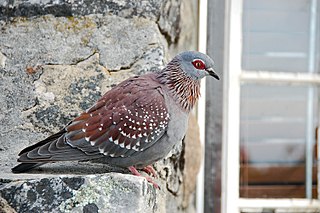
The speckled pigeon, also African rock pigeon or Guinea pigeon, is a pigeon that is a resident breeding bird in much of Africa south of the Sahara. It is a common and widespread species in open habitats over much of its range, although there are sizable gaps in its distribution. It is sometimes referred to as the Guinea pigeon due to its similar coloring to some species of guineafowl.
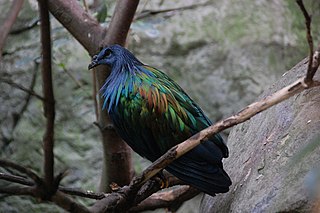
The Nicobar pigeon or Nicobar dove is a bird found on small islands and in coastal regions from the Andaman and Nicobar Islands, India, east through the Indonesian Archipelago, to the Solomons and Palau. It is the only living member of the genus Caloenas alongside the extinct spotted green pigeon and Kanaka pigeon, and is the closest living relative of the extinct dodo and Rodrigues solitaire.

The laughing dove is a small pigeon that is a resident breeder in Africa, the Middle East, South Asia, and Western Australia where it has established itself in the wild after being released from Perth Zoo in 1898. This small long-tailed dove is found in dry scrub and semi-desert habitats where pairs can often be seen feeding on the ground. It is closely related to the spotted dove which is distinguished by a white and black chequered necklace. Other names include laughing turtle dove, palm dove and Senegal dove while in Asia the name little brown dove is often used.

The vinaceous dove is a bird species in the pigeon family Columbidae that widely resident across the Sahel and Sudan (region).

The green imperial pigeon is a large forest pigeon. The large range extends from Nepal, southern India and Sri Lanka eastwards to southern China, Indonesia and the Philippines.

The common ground dove is a small bird that inhabits the southern United States, parts of Central America, the Caribbean and northern South America. It is considered to be the smallest dove that inhabits the United States. As its name suggests, the bird spends the majority of its time on the ground walking but still has the ability to fly.

The Namaqua dove is a small pigeon. It is the only species in the genus Oena. It is found over much of Sub-Saharan Africa as well as Arabia and Madagascar.
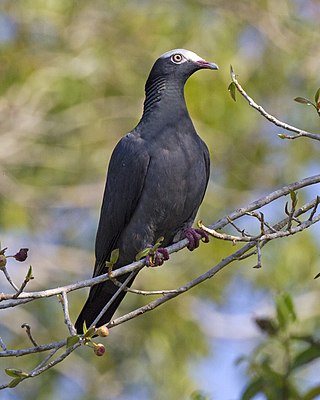
The white-crowned pigeon is a fruit and seed-eating species of bird in the dove and pigeon family Columbidae. It is found primarily in the Caribbean.

The zebra dove, also known as the barred ground dove, or barred dove, is a species of bird of the dove family, Columbidae, native to Southeast Asia. They are small birds with a long tail, predominantly brownish-grey in colour with black-and-white barring. The species is known for its pleasant, soft, staccato cooing calls.

The ruddy quail-dove is a species of bird in the dove and pigeon family Columbidae. It breeds throughout the West Indies, Central America, and tropical South America. It has appeared as a vagrant in Florida and southern Texas. It lays two buff-colored eggs on a flimsy platform built on a shrub. Some nests are built on the ground.

The claret-breasted fruit dove is a species of bird in the family Columbidae. It is found in the Moluccas, New Guinea and the Solomon Islands archipelago. Its natural habitat is subtropical or tropical moist lowland forests.

The thick-billed green pigeon is a species of bird in the family Columbidae.

The Christmas emerald dove, also known as the Christmas green-winged pigeon, is a bird in the pigeon family, Columbidae. It is a distinctive subspecies of the common emerald dove that is endemic to Christmas Island, an Australian territory in the eastern Indian Ocean.
In the 10th edition of Systema Naturae, published in 1758, the Swedish naturalist Carl Linnaeus described 554 species of bird and gave each a binomial name.

The Pacific emerald dove or brown-capped emerald dove is a pigeon which is a widespread resident breeding bird in the tropical and sub-tropical parts of Indonesia to northern and eastern Australia. It was formerly conspecific with the common emerald dove.
